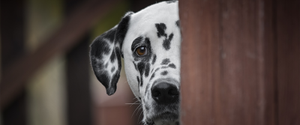
Every dog has a unique personality, and yours is no different. Most are full of fun and curiosity, but nearly all dogs have some fears too. And while it’s only natural for dogs to be afraid of things, some dogs are more predisposed to fear than their four-legged counterparts. Your dog may suffer from anxiety about a number of things, situations or places. Knowing what causes dog anxiety and how to calm dog anxiety can be helpful to caring pet parents looking to support their pets and combat unwanted behaviour.
It is important as a pet owner that you get to know your dog’s distinctive personality as much as possible. Knowing your dog can help you discover what makes him uneasy and lets you predict what may cause certain behaviours in your dog that are brought on by his anxieties.
More importantly, knowing what triggers your dog’s nervousness can help you formulate coping strategies to help him deal with his fears and support him when he is anxious. After all, most canine behaviour issues can be traced back to fears — this includes aggressive actions. Fear doesn't just cause aggression; nearly any behavioural issue you have with your dog has roots in your dog being frightened, scared, worried, apprehensive or anxious.
Behavioural Issues Caused by Dogs’ Anxiety
There are five common issues that result directly or indirectly from a dog’s feelings of anxiousness or fear. These include:
- Canine separation anxiety. This is the fear of being alone or of the pet parent leaving. Some dogs may even sit at the door all day, waiting for their humans to arrive back home.
- Guarding of resources. The fear of losing a valued item can lead a dog to act aggressively, whether it’s a treasured toy, food or something else.
- Noise phobia. Strange noises or sudden noises can cause dogs to become frightened, leading to aggression and other undesirable behaviours. This is oftentimes the case when a dog is afraid of fireworks or thunder.
- Aggression towards people. Typically, dogs are more aggressive toward people they do not know. However, various fears can lead a normally docile dog to become aggressive with family members and other familiar humans.
- Dog-to-dog aggression. Strange dogs can be a source of fear and anxiety for a dog. In the same vein, strange dogs that show aggression toward a dog can cause it to become aggressive to retaliate.
Some other doggy behaviour issues that result from dogs’ fears include reactivity and hyperactivity as well as not paying attention when the dog is away from a familiar place. Some dog owners may say that the dog is good at home but that he refuses to listen or obey away from home. This generally means that the dog is relaxed and confident in his own territory, but once his surroundings change and he’s exposed to strange dogs and people, he becomes anxious. What happens is easy to understand. When the dog is in a new place or experiencing a new situation, he may sense a threat — either real or imagined. This makes him more cautious than he normally would be, and sometimes, his normally good behaviour is chucked to the wayside while he tries to cope with the new feelings he’s having. He has to determine for himself that he’s safe before his behaviour returns to normal.
What Are the Signs of Anxiety in a Dog?
One of the most common things that happens to a dog with anxiety is that his “fight” or “flight” response kicks into overdrive. He may try to intimidate a perceived threat — which could be a human being or another animal. He may also run away from something that he finds threatening, whether it’s another dog or a situation where he feels uneasy or stressed. By recognizing that your dog is experiencing anxiety, you can help quell his fears and ease his tension. Some signs to watch for in your four-footed fur buddy include:
- Attempting to or actually hiding
- Aggression
- Hyperactivity
- Inability to settle
- Lack of attention due to distraction
- Lack of or reduced appetite
- Lip licking
- Lowered body language
- Pacing
- Panting
- Reactivity
- Regression from toilet training
- Salivation
- Shaking and/or trembling
- Showing the whites of the eyes
- Silly behaviour
- Snarling, howling or growling
- Yawning
Any of these signs can be indicative that your dog is anxious. This can be anxiety in response to specific stimuli or even to a situation that makes your dog fearful or uncomfortable.
How to Help Your Anxious Dog
Your dog’s anxiety can be helped if you are patient and understanding — and you take the time to help him cope with his fears. Some tips:
- Keep your dog away from loud noises if he appears to be scared of things like fireworks.
- Give your dog a good supplement that helps him stay calm, especially if you are planning on a new situation or other event that may upset your pet.
- Help your dog avoid attention-seeking behaviours by ensuring that he gets plenty of social interaction and exercise each day. Use a leash to help control your dog if he acts up around people.
- Don’t forget that your dog needs socialization with other animals too. A walk around the local park a few times a week or more often can help him become more well-rounded and adjusted to being around other animals.
- Quietly remove your dog from situations where you believe he’s anxious, especially if he’s being aggressive.
- Study your dog’s body language, so you can be warned well in advance when your dog is acting out.
- Learn about desensitization, which is a type of therapy for dogs that exposes them to things that cause them fear so that they can learn rational responses to their triggers. Work with a dog behaviourist if needed.
- Have your dog microchipped. Because the “fight or flight” response is high in anxious dogs, your dog may run away and become injured or lost. A microchip can help you locate your dog if he runs off.
Your dog depends largely on you to make sure that he feels safe and secure. Recognizing his anxiety is the first step in helping him to become less fearful so that he can more thoroughly enjoy his life — no matter where he may roam.
Related articles



